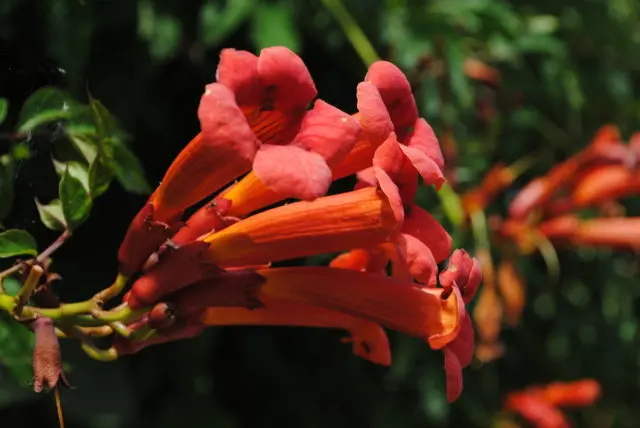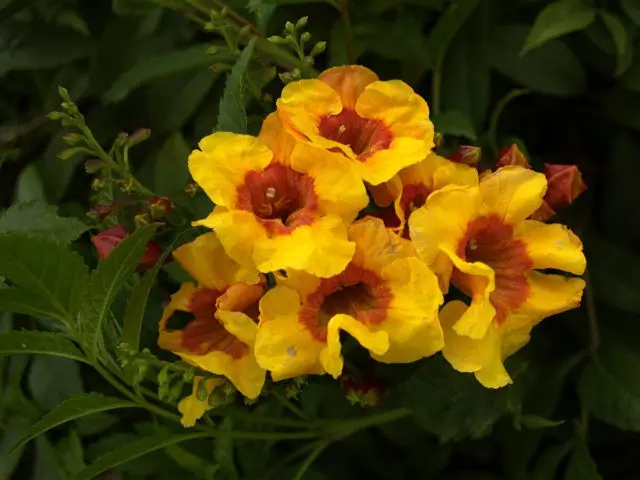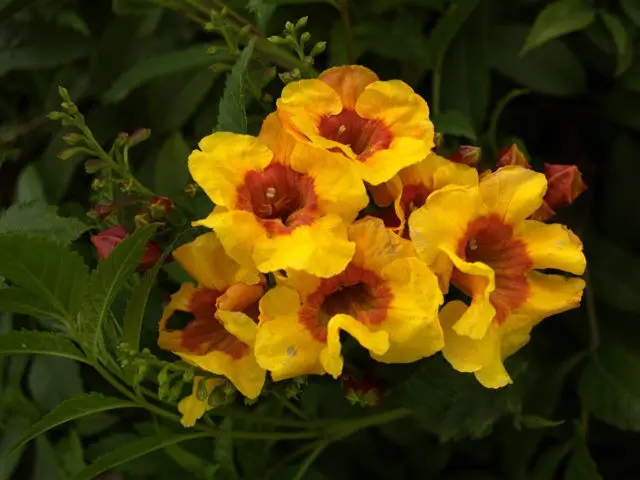Contents
Reproduction of kampsis at home is not difficult for gardeners. There are several methods for this procedure, but the most preferred of all is cuttings. Reproduction using seeds is inefficient, since after planting the planting material, the flowering of the crop will begin no earlier than in 5-7 years.
Principles and methods of reproduction of kampsis

Another name for Kampsis is rooting tekoma.
Campsis is a perennial plant that can live in one place for a long time without a transplant. Its aggressive nature is known among gardeners. The root system of culture develops in such a way that in the process of growth it captures vast territories. That is why, when landing, they limit the space to it, digging some fences into the ground.
But campsis is a very beautiful plant that many propagate on their plots. The culture blooms unusually. The buds, blooming, acquire a bright color – scarlet or orange. At the same time, gradual flowering is characteristic, thus, each flower opens the petals in turn, increasing the duration of budding.
To create a cozy corner on your site with the help of campsis liana, you need to understand the nuances of its reproduction, as well as choose the most appropriate method. Common methods include: seed, with the help of root shoots, layering and cuttings. Each of them has advantages and disadvantages.
Optimal timing
Kampsis breeding time directly depends on the chosen method. When dividing by cuttings, the process must begin in the spring. Suitable shoots are cut, rooted, and can be planted in open ground in 2-3 months.
Propagation of Kampsis by seeds is a very laborious process; few gardeners use it. But it is necessary to start planting material for future seedlings in March, in order to plant sprouts in open ground by May.
If it is planned to propagate Kampsis by root shoots, then this should be done only before the start of sap flow. This is the period of early spring or late autumn.
How to propagate kampsis at home

Kampsis flowers of a unique shape, bright color, odorless
The most effective breeding methods for Kampsis are vegetative. Regardless of which particular one is chosen – layering, cuttings or root shoots, they have a fairly high percentage of rooting. However, it is necessary to take care of the young plant. Vegetative propagation methods cannot be called complex, especially if the gardener has some experience. In addition, they have an important advantage over the seed method of reproduction – the complete preservation of varietal characteristics.
How to propagate Kampsis cuttings
Propagation of Kampsis by cuttings in autumn or spring is one of the most effective methods, since the survival rate of the material is more than 90% with proper care. It is worth noting that grafting can be done in several ways – with green or lignified processes.
Green
Many gardeners propagate kampsis with the help of green cuttings, since the survival rate of a young plant is high, and this procedure is simple. To do this, it is necessary to cut a couple of young shoots from the middle of the bush in the summer. Keep the center of the stem along with a few leaves that should be shortened. Next, the lower end must be treated with a preparation to stimulate the root system and planted in fertile soil. For fast and effective rooting, it is necessary to water the stalk frequently. It will be useful to mulch the soil around the plant so that the moisture does not evaporate too quickly.
The choice of landing site must be taken seriously. A young culture needs partial shade, direct sunlight can be harmful.
woody
The survival rate of lignified cuttings reaches 100%, so gardeners prefer to use it. The cut of last year’s sprouts is carried out in early spring. It is important to use a sharp, disinfected instrument to prevent infection. You need to choose healthy branches that are slightly covered with cracks. There should be several leaf blades and 2-3 buds on the handle. It is recommended to stick it at an acute angle in containers with fertile soil, and after 2-3 months, with successful rooting, transplant the plant into open ground.

Perennial has several breeding options and each is effective to a different degree.
Propagation of Kampsis seeds
Reproduction of any plant by seeds, on the one hand, is considered easy, on the other hand, it will require increased attention to the process. Few gardeners resort to the seed propagation method for several important reasons:
- the method is rather laborious;
- flowering plant will begin no earlier than 5-7 years;
- there is no guarantee of the preservation of varietal characteristics;
- the seeds may not be suitable for the conditions of detention, especially the climate.
However, if there are seeds and a desire to propagate Kampsis in this way, then you should start by preparing the soil. It should be nutritious, consist of high-quality purchased soil with the addition of peat. In addition, it is important that it be crumbly, have a neutral reaction and hold moisture well.
Seeds are laid in small depressions and watered as needed. Be sure to monitor the maintenance of the required temperature in the room. After about a month, shoots will appear, and after the formation of the third leaflet, seedlings can be planted in open ground.
How to propagate Kampsis root shoots
Under favorable conditions, proper care, Kampsis gives abundant root shoots. A healthy shoot can be carefully removed from the soil along with part of the root. It is recommended to immediately transplant to a permanent place of growth. The best time for this procedure is before or after sap flow.
Kampsis propagation by layering
The easiest way to propagate kampsis is with the help of layering. This method is used by many beginners in gardening, as it does not require separation of the layer from the mother bush in the early stages. To begin with, you should select a few healthy processes. Dry, rotten, injured and affected by disease or insects are not suitable for reproduction.

Kampsis petals have a variety of shades, but they are all bright and attract attention.
Healthy branches should be tilted close to the soil and carefully fixed in this position. This can be done with wire, and soil should be poured on top of the branches. In this case, the middle of the stems should be covered with soil, and their top should remain free. Moisten the part that is under the ground regularly with water so that rooting begins faster. After 1-1,5 months, you should carefully look at the root system – how much it has developed.
Next spring, you can separate the plant from the mother bush, transplant to a new place. Pruning is important to have time to make before the start of sap flow. You need to cut off the layers with a sharp tool 8 cm above the buried part.
Transfer to a permanent place
When transplanting Kampsis to a new place, it should be noted that the plant loves warmth and sunlight. With a planned transplant, the best time is after the end of frost, while you need to prepare the soil in advance, dig a suitable hole and make good drainage. At the plant, carefully straighten the roots, cover with soil and tamp.
Conclusion
Reproduction of kampsis is possible in several ways. Each of the gardeners chooses the one that is most preferable to him. All methods give good results, subject to competent actions, proper care and the right choice of the place where the culture grows.









